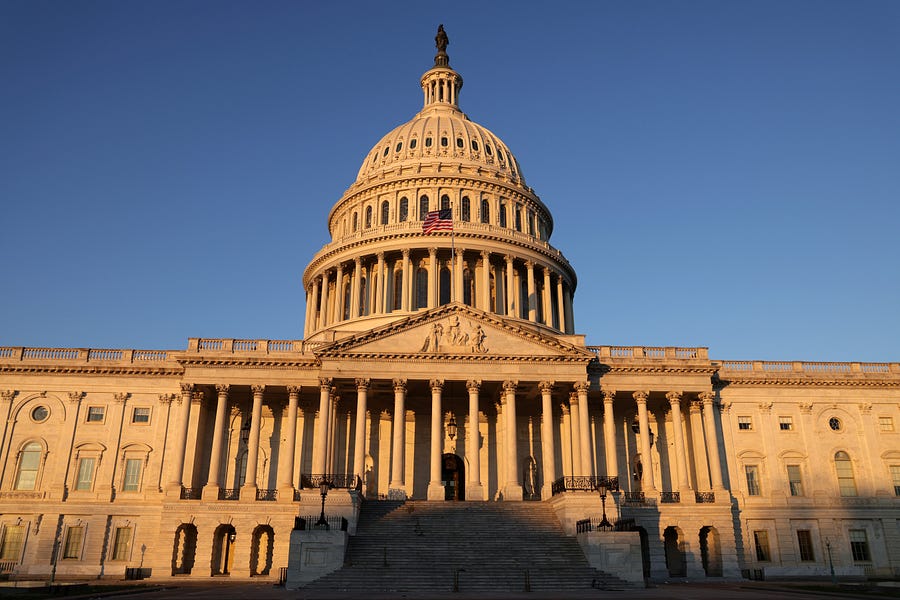In 2010, my former boss, the late U.S. Sen. Tom Coburn (R-Oklahoma), did something “the establishment” thought was impossible. He won an outsider, insurgent struggle against pork-barrel spending. Five years earlier, in 2005, we lost an amendment to kill a little-known pork barrel project that came to be called the Bridge to Nowhere in Alaska by 67 votes. The lopsided 82-15 tally actually made our victory possible. The loss didn’t embarrass Coburn, it embarrassed Congress. The vote turned Coburn into a folk hero (the Wall Street Journal called him “Coburn the Barbarian”), Parade magazine put the bridge on its cover, and millions of taxpayers were horrified to see just how out of touch and corrupt the modern Congress had become.
After the 2010 Tea Party election, Sen. Mitch McConnell, who supported earmarks, actually put the ban into effect. “Old habits aren’t easy to break,” McConnell said, “but sometimes they must be. And now is such a time.”
Every year since, politicians in both parties have said this was the year earmarks would be coming back. Every year they have been wrong. While the ban was bent, it never went away. Yet, with Democrats in control of all three branches of government, and Republicans shell-shocked, confused, and adrift in the age of post-Trump Trumpism, the earmark ban is under assault again.
House Majority Leader Steny Hoyer (D-Maryland) is approaching his colleagues with a political seduction ploy that is predictable, but no less grotesque for that. According to reports, Hoyer privately promised Democrats’ earmarks would be limited to “nonprofits” and for state and local government. He also promised Democrats they wouldn’t take the heat for restarting a special interest spending orgy because it would be “bipartisan.”
The past few days have seen a parade of conventional wisdom arguments that are as baseless today as they were 10 and 20 years ago.
First, we’re hearing that earmarks are the lubrication Congress needs to get working again. Earmark enthusiasts (which we called “earmarxists”) have trouble describing this earmark-enabled Golden Age of compromise and productivity because it doesn’t exist. Yes, there has always been graft, parochialism, and politics in politics, but earmarks as they existed in the 1990s and 2000s were a unique and disgraceful aberration in American history. Previous Congresses somehow managed to rebuild the country after the Civil War, build railroads and highways, and win World War II without giving politicians walking-around money to build teapot museums and parking garages.
Earmarks were quite rare for most of our history. President Ronald Reagan vetoed a highway bill in 1987 because it contained 121 earmarks. In the next decade, the practice took off. In 1994, there were about 4,000 earmarks; there were 16,000 in 2006. Facts matter. Like QAnon, the earmark history peddled by earmarxists and spending extremists is just made up. It’s a spending cult that should never be reassembled.
Second, we’re hearing that earmarks themselves are usually good projects that fund and facilitate good outcomes. In a piece in The Atlantic headlined “Earmarks Are Good,” Annie Lowery makes the case that a little taxpayer-supported bribery of U.S. Sen. Joe Manchin (D-West Virginia) would produce a range of desirable progressive outcomes. It’s true that Congress has funded good projects in spite of itself, but a significant body of research and analysis shows that earmarks are, on average, harmful and sometimes terribly destructive.
A Harvard study in 2010 showed that powerful members who were most adept at bringing home the bacon actually damaged their districts by misallocating capital and distorting local economies. The study found that earmarks decreased private investment and expenditures by 15 percent. Joshua Coval, one of the study’s authors, said, “It was an enormous surprise, at least to us, to learn that the average firm in the [committee] chairman’s state did not benefit at all from the unanticipated increase in spending.”
The Department of Transportation showed that earmarks divert funding from higher priority projects like repairing bridges that are in danger of collapsing. Earmarks also hurt out national security and our troops. Former Republican House Speaker Newt Gingrich pushed earmarks for airplanes the Pentagon didn’t want because they were made in his district.
In 2005, Oregon Democratic Rep. David Wu secured a $2 million earmark for a company that made T-shirts for Marines. Tragically, the poorly made T-shirts melted in intense heat, adhering to a soldier’s skin. A military surgeon told the Seattle Times, “This essentially creates a second skin and can lead to horrific, disfiguring burns.” As the Wu examples shows, empowering Congress to pick winners and losers tends to punish winners and reward losers.
Both sides should consider how the “members know best” earmark culture could affect challenges like climate change and pandemic preparedness. Now, many Democrats care less about climate change and more about using climate alarmism to push socialist goals like Medicare for All and free college. But some Democrats do care, along with the Republicans who believe President Donald Trump meant it when he said “I don’t think it’s a hoax.”
Bill Gates wants the federal government to spend $35 billion on additional basic research and development to promote clean energy. Congress could recycle government waste to fund that work, but the outcome depends on who has the funding authority. If funding decisions are made via earmarks, Bill Gates, Elon Musk, and MIT won’t be making those decisions. They’ll be answering to 23-year-old appropriations staffers for Steny Hoyer. That’s hardly a recipe for success. Instead of funding catalyst projects, Congress will fund a lot of, well, crap. Democrats and Republicans who want funding decisions about pressing national challenges to be made on the basis of science, facts, evidence and sound economics should oppose a revival of earmarks.
Finally, Hoyer and many other career politicians incessantly complain they just want their power back and that Congress shouldn’t leave spending decisions to unelected bureaucrats. If Steny Hoyer doesn’t like the decisions bureaucrats are making, he has no one to blame but himself. Congress can constrain the administrative state at will through its power of the purse. The fact is, most politicians would rather spend money than save money. At the height of earmark fervor, the number of earmark requests outnumbered the number of oversight hearings by a factor of 1,000 to 1. That disgraceful imbalance is solely Congress’s fault.
And contrary to conventional wisdom, the earmark ban did restrain spending, at least initially. Coburn was right that earmarks were a gateway drug to Washington’s spending addiction. In 2013, federal spending went down for the first time since the Korean War. Yet, we never argued that the earmark ban would solve our national challenges and eliminate the debt. We were looking for incremental wins. Shutting down the earmark culture was an attempt to create a moment of sanity and sobriety that would help long-term thinking prevail over short-term political expediency and opportunism.
Sadly, this moment of sobriety was derailed when Sen. Ted Cruz told the Republican base the new cause de jour was shutting down the government until President Obama agreed to defund his signature achievement, Obamacare. Telling the GOP base that conservatives could win by taking ourselves hostage and begging the other side not to shoot proved to be a bad omen. Cruz opened a portal to the Upside Down. His small lie grew up to become Donald Trump’s big lie.
Fiscal conservatism—and constitutional conservatism—are hardly in ascent on the right, but politics is fluid and ever-changing. Not long ago, a principled populist named Tom Coburn identified a rumble among the electorate and used principled, conservative, sometimes entertaining, and well-researched arguments to energize the base. Had the “establishment” been quicker to agree with him, we may have avoided some of the less productive chapters that followed.
Hoyer’s hedging shows the enduring power of the arguments we won decisively in the public square. In the 1990s and 2000s, earmarks became widely ridiculed symbols of excess, not unlike the Roman-era Bacchanalia or pleasure festivals. When taxpayers realized they were the ones being molested by Washington’s special interest-financed spending orgies, they revolted. Hoyer’s plan to limit earmarks to the “nonprofit” sector is a farce that would corrupt civil society while biding his time to restart Washington’s full-scale spending orgies.
Republicans should follow Nikki Haley’s lead and tell voters that carrying on President Trump’s efforts to drain the swamp should not involve restarting a process disgraced lobbyist Jack Abramoff called an “earmark favor factory.” Democrats should join Republicans in a fiscal sanity coalition that puts merit, science and sound economics over political favoritism and opportunism.
Bringing back earmarks would be like opening a bar tab for a group of recovering alcoholics. Members of Congress are deluding themselves if they think taxpayers want them to restart this process behind the safety of barricades and thousands of national guard troops. Progressives who care about economic justice and conservatives who care about fiscal restraint should think twice before betraying their core principles. As the old bulls—the appropriators—and other members learned in the 2000s, the politics of pork can be brutal and unforgiving.
John Hart, who served as U.S. Sen. Tom Coburn’s longtime communications director and co-author, is the co-founder of the Conservative Coalition for Climate Solutions.






Please note that we at The Dispatch hold ourselves, our work, and our commenters to a higher standard than other places on the internet. We welcome comments that foster genuine debate or discussion—including comments critical of us or our work—but responses that include ad hominem attacks on fellow Dispatch members or are intended to stoke fear and anger may be moderated.
With your membership, you only have the ability to comment on The Morning Dispatch articles. Consider upgrading to join the conversation everywhere.